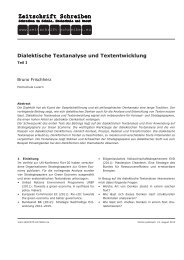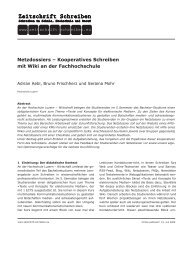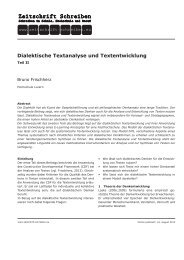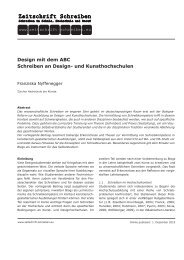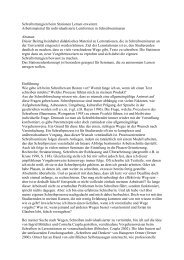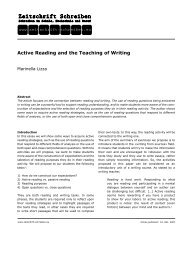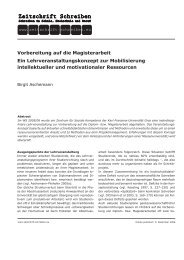An Approach to Teaching the Writing of Literature Reviews
An Approach to Teaching the Writing of Literature Reviews
An Approach to Teaching the Writing of Literature Reviews
Create successful ePaper yourself
Turn your PDF publications into a flip-book with our unique Google optimized e-Paper software.
<strong>An</strong> <strong>Approach</strong> <strong>to</strong> <strong>Teaching</strong> <strong>the</strong> <strong>Writing</strong> <strong>of</strong> <strong>Literature</strong> <strong>Reviews</strong><br />
Elizabeth Turner<br />
John Bitchener<br />
Auckland University <strong>of</strong> Technology<br />
Auckland University <strong>of</strong> Technology<br />
Abstract<br />
Students face difficulties in writing literature reviews that relate in particular <strong>to</strong> limited knowledge <strong>of</strong> <strong>the</strong> genre<br />
(Bruce, 1992; E. Turner, 2005). While <strong>the</strong>re has been valuable research relating <strong>to</strong> genre and discourse analysis<br />
<strong>of</strong> <strong>the</strong> literature review (such as Bun<strong>to</strong>n, 2002; Kwan, 2006; O’Connell and Jin, 2001), <strong>the</strong>re is a lack <strong>of</strong> research<br />
in<strong>to</strong> <strong>the</strong> effectiveness <strong>of</strong> published writing support programmes. Fur<strong>the</strong>rmore, with exceptions such as Ridley<br />
(2000) and Swales and Lindemann (2002), <strong>the</strong>re is little explicit advice on how <strong>to</strong> approach <strong>the</strong> teaching <strong>of</strong> <strong>the</strong><br />
literature review. This paper reports on one <strong>of</strong> two studies described at <strong>the</strong> 4th International EATAW conference<br />
2007. It describes an evaluation <strong>of</strong> <strong>the</strong> effectiveness <strong>of</strong> an approach at a New Zealand university <strong>to</strong> teaching <strong>the</strong><br />
writing <strong>of</strong> literature reviews. It focuses on a 15-hour unit <strong>of</strong> teaching as part <strong>of</strong> a six-day EAL graduate writing<br />
course. The study found clear evidence <strong>of</strong> improvement in all areas that were targeted.<br />
Introduction<br />
Taught papers in graduate diploma and postgraduate<br />
programmes <strong>of</strong>ten include literature review assignments,<br />
and <strong>the</strong>se have even emerged as a form <strong>of</strong><br />
written assessment at undergraduate level in some<br />
disciplines (Turner, 2005). The literature review is<br />
an important sub-genre <strong>of</strong> postgraduate research<br />
proposals, dissertations and <strong>the</strong>ses, and also is a<br />
significant research genre in its own right (Cooper,<br />
1988). However, reviewing <strong>the</strong> literature presents<br />
special challenges, particularly for EAL (English as an<br />
Additional Language) students. <strong>Writing</strong> a literature<br />
review involves a syn<strong>the</strong>sis <strong>of</strong> a complex range <strong>of</strong><br />
analytical and rhe<strong>to</strong>rical skills as well as academic<br />
writing skills, and an understanding <strong>of</strong> what is meant<br />
by critical analysis and argument. In <strong>the</strong> authors’<br />
experience <strong>of</strong> teaching writing support programmes at<br />
both graduate and postgradate levels, while some EAL<br />
students are able <strong>to</strong> give a fairly accurate summary<br />
<strong>of</strong> <strong>the</strong> functions <strong>of</strong> a literature review, not one has<br />
been able <strong>to</strong> explain <strong>the</strong> concept <strong>of</strong> argument in <strong>the</strong><br />
context <strong>of</strong> academic genres, even though this term is<br />
frequently used. It needs <strong>to</strong> be recognised, however,<br />
that different perceptions <strong>of</strong> <strong>the</strong> meaning <strong>of</strong> argument<br />
stem from different cultural, linguistic and educational<br />
traditions with different priorities in terms <strong>of</strong> what is<br />
valued in academic texts (Canagarajah, 1996).<br />
A summary <strong>of</strong> relevant graduate and postgraduate<br />
student needs includes, in general terms: an awareness<br />
<strong>of</strong> <strong>the</strong> rhe<strong>to</strong>rical and linguistic conventions <strong>of</strong> relevant<br />
texts (Dudley-Evans, 1995), critical thinking skills (Zhu,<br />
2004) and <strong>the</strong> ability <strong>to</strong> syn<strong>the</strong>sise information from<br />
multiple sources (Carson, 2001; Zhu, 2004), along<br />
www.zeitschrift-schreiben.eu<br />
Online publiziert: 11. Juni 2008
with summarising, paraphrasing and citation skills.<br />
More specifically related <strong>to</strong> <strong>the</strong> literature review, Carson<br />
(2001) identifies <strong>the</strong> need for students <strong>to</strong> be able <strong>to</strong><br />
meet <strong>the</strong> cognitive demands posed by <strong>the</strong> critical review<br />
assignment and <strong>to</strong> organise a coherent analysis, while<br />
Allison, Cooley, Lewkowicz and Nunan (1998) point out<br />
<strong>the</strong> need <strong>to</strong> be able <strong>to</strong> sustain an argument over an<br />
extended text. Based on <strong>the</strong> present authors’ teaching<br />
experience, our premise is firstly that students need <strong>to</strong><br />
be able <strong>to</strong> understand what is meant by argument in<br />
this context and secondly, that <strong>the</strong> ability <strong>to</strong> construct<br />
a coherent and cohesive argument over <strong>the</strong> length <strong>of</strong> a<br />
short text is a prerequisite for constructing an extended<br />
argument over a longer text.<br />
This paper summarises a study that sought <strong>to</strong> evaluate<br />
<strong>the</strong> effectiveness <strong>of</strong> an approach <strong>to</strong> teaching <strong>the</strong> writing<br />
<strong>of</strong> a short literature review. The aim was <strong>to</strong> investigate<br />
<strong>the</strong> extent <strong>to</strong> which graduate EAL students were able <strong>to</strong><br />
produce a coherent and logically-structured argument<br />
in a short literature review at <strong>the</strong> end <strong>of</strong> a 15-hour unit<br />
<strong>of</strong> teaching. The paper summarises relevant literature,<br />
provides details including a summary <strong>of</strong> <strong>the</strong> teaching<br />
approach, <strong>the</strong> study design, and <strong>the</strong> focus <strong>of</strong> features <strong>of</strong><br />
analysis, and provides a discussion <strong>of</strong> key findings. The<br />
final section outlines <strong>the</strong> limitations and conclusions.<br />
<strong>Literature</strong> Review<br />
Student difficulties and published advice<br />
There has been considerable research in<strong>to</strong> sentence and<br />
paragraph level difficulties encountered by graduate<br />
EAL students (for example, Bitchener and Basturkmen,<br />
2006; Cooley and Lewkowicz, 1997; Dong, 1998;<br />
Hinkel, 2003; James, 1993). O<strong>the</strong>r difficulties relate <strong>to</strong><br />
restricted rhe<strong>to</strong>rical and genre knowledge, as well as<br />
limited understanding <strong>of</strong> content parameters <strong>of</strong> different<br />
sections <strong>of</strong> a <strong>the</strong>sis, and difficulties in sequencing and<br />
developing an argument coherently (Bitchener and<br />
Basturkmen, 2006; Cadman, 1997; Casanave and<br />
Hubbard, 1992). More specifically, Bruce (1992), Turner<br />
(2005) and Bitchener and Banda (2007) have identified<br />
low levels <strong>of</strong> student understanding <strong>of</strong> <strong>the</strong> functions <strong>of</strong><br />
a literature review and <strong>of</strong> its characteristics.<br />
There is published advice on academic writing. However,<br />
texts tend <strong>to</strong> make assumptions about students’<br />
knowledge and understanding <strong>of</strong> <strong>the</strong> functions and<br />
features <strong>of</strong> a literature review (Paltridge, 2002), or<br />
employ analogies that are ei<strong>the</strong>r complex (Krathwohl<br />
and Smith, 2005) or that tend <strong>to</strong> be culturally-specific<br />
<strong>to</strong> those who use English as a first language (Kamler<br />
and Thomson, 2006). Swales and Lindemann (2002)<br />
also point out that <strong>the</strong>re is a division in currently<br />
available material between a focus on generalities,<br />
including some possible ways <strong>of</strong> organizing a review,<br />
and specifics such as choice <strong>of</strong> reporting verbs, tense<br />
use, and forms <strong>of</strong> citation. At issue is how student<br />
writers can be inducted in<strong>to</strong> <strong>the</strong> analytical processes by<br />
which <strong>the</strong>y learn <strong>to</strong> bridge <strong>the</strong> ground between <strong>the</strong>se<br />
macro and micro levels <strong>of</strong> research and advice.<br />
Support programmes<br />
Institutional support for students writing at this level<br />
is provided in a variety <strong>of</strong> ways, including seminars,<br />
workshops (Sachtleben, Strauss, and Turner, 2007;<br />
Woodward-Kron, 2002), and credit-bearing, taught<br />
writing courses. Discussions <strong>of</strong> five EAL graduate<br />
writing programmes have been published by Allison,<br />
Cooley, Lewkowicz and Nunan (1998), Dudley-Evans<br />
(1995), Frodesen (1995), Richards (1988) and Silva,<br />
Reichelt and Lax-Farr (1994). A variety <strong>of</strong> approaches<br />
are described, with Dudley-Evans’ description <strong>of</strong> <strong>the</strong><br />
programme at <strong>the</strong> University <strong>of</strong> Birmingham providing<br />
information on content that might be considered for an<br />
approach <strong>to</strong> teaching <strong>the</strong> writing <strong>of</strong> literature reviews.<br />
A fur<strong>the</strong>r and interesting report describes an approach<br />
related specifically <strong>to</strong> teaching <strong>the</strong> writing <strong>of</strong> literature<br />
reviews on a dissertation and prospectus writing course<br />
(Swales and Lindemann, 2002). This includes materials<br />
used and examples <strong>of</strong> <strong>the</strong> ways in which students<br />
from a variety <strong>of</strong> disciplinary backgrounds organized<br />
information in a short text. However, while three <strong>of</strong><br />
<strong>the</strong> programmes were evaluated by <strong>the</strong> teachers and<br />
students, none <strong>of</strong> <strong>the</strong> six reports mentions any attempt<br />
<strong>to</strong> measure <strong>the</strong> effectiveness <strong>of</strong> what was <strong>of</strong>fered in<br />
<strong>the</strong> course <strong>of</strong> study. There appears <strong>to</strong> be a significant<br />
gap in <strong>the</strong> published literature regarding attempts that<br />
might have been made <strong>to</strong> evaluate <strong>the</strong> effectiveness <strong>of</strong><br />
programmes.<br />
Argument<br />
The construction <strong>of</strong> a logical argument is central <strong>to</strong> an<br />
effective literature review, and can be defined as <strong>the</strong><br />
logical sequencing <strong>of</strong> propositions, or a logical process<br />
<strong>of</strong> reasoning, which is realised in <strong>the</strong> relationships<br />
between propositions. James’ discussion (1993) is<br />
relevant and focuses on <strong>the</strong> global organisation <strong>of</strong><br />
‹external› propositions that are categorised ei<strong>the</strong>r as<br />
superordinate or subordinate (see below). In her genre<br />
Elisabeth Turner and John Bitchener: «<strong>An</strong> <strong>Approach</strong> <strong>to</strong> <strong>Teaching</strong>» www.zeitschrift-schreiben.eu 11.6.2008 Seite: 2/10
analysis <strong>of</strong> <strong>the</strong> rhe<strong>to</strong>rical structure <strong>of</strong> <strong>the</strong>matic units in<br />
Ph.D. <strong>the</strong>sis literature review chapters, Kwan (2006)<br />
investigates <strong>the</strong> structure <strong>of</strong> rhe<strong>to</strong>rical argument, at <strong>the</strong><br />
level <strong>of</strong> rhe<strong>to</strong>rical moves, steps or strategies. The notion<br />
<strong>of</strong> moves and strategies reflects, at different levels, <strong>the</strong><br />
rhe<strong>to</strong>rical purpose <strong>of</strong> sections <strong>of</strong> text. Kwan identifies<br />
three categories <strong>of</strong> unit: introduc<strong>to</strong>ry texts; <strong>the</strong>matic<br />
units with a predominant recursive arrangement <strong>of</strong><br />
Move 1 (Establishing a terri<strong>to</strong>ry, or relevant <strong>the</strong>mes)<br />
and 2 (Establishing a niche) (see CARS model in Bun<strong>to</strong>n,<br />
2002; Swales, 1990); and thirdly concluding texts.<br />
Also relevant <strong>to</strong> argument, rhe<strong>to</strong>rical structure <strong>the</strong>ory<br />
(Mann and Thompson, 1983, 1986) centres on <strong>the</strong> idea<br />
that text coherence is dependent on rhe<strong>to</strong>rical relations<br />
between units <strong>of</strong> text, which at a micro level can be<br />
analysed in terms <strong>of</strong> structural organisation. Accordingly,<br />
rhe<strong>to</strong>rical relations are defined in terms <strong>of</strong> <strong>the</strong> effect<br />
<strong>the</strong> writer intends by juxtaposing units <strong>of</strong> text, where<br />
<strong>the</strong> minimal unit <strong>of</strong> organisation is <strong>the</strong> clause; <strong>the</strong>se<br />
relations are described as independent <strong>of</strong> linguistic<br />
devices, such as conjunctions, that may be used <strong>to</strong><br />
signal <strong>the</strong>m. However, Hyland and Tse (2004) point<br />
out that metadiscourse, including conjunction, plays<br />
a significant role in <strong>the</strong> coherent construction <strong>of</strong> both<br />
propositional and interpersonal elements, and also point<br />
out <strong>the</strong> ideational function that conjunction can fulfil in<br />
signalling <strong>the</strong> writer’s perception <strong>of</strong> <strong>the</strong> relationships<br />
between ideas. Thus, argument, in <strong>the</strong> context <strong>of</strong> <strong>the</strong><br />
literature review, involves not only <strong>the</strong> identification <strong>of</strong><br />
global relationships in ‹external› propositional content,<br />
and <strong>the</strong> organisation <strong>of</strong> propositions within <strong>the</strong>matic<br />
units, but also <strong>the</strong> logical juxtaposition <strong>of</strong> units <strong>of</strong> text,<br />
as well as <strong>the</strong> use <strong>of</strong> metadiscourse that makes explicit<br />
<strong>the</strong> relationships between <strong>the</strong>se. A coherent argument<br />
in a literature review, <strong>the</strong>refore, is dependent on <strong>the</strong><br />
successful organization and integration <strong>of</strong> ‹external›<br />
propositional content and effective metadiscourse.<br />
Introduction <strong>to</strong> <strong>the</strong> Study<br />
While research has identified student difficulties in<br />
writing literature reviews and in developing a coherent<br />
extended argument, as well as students’ lack <strong>of</strong> relevant<br />
genre and discourse knowledge, <strong>the</strong> literature suggests<br />
that <strong>the</strong>re is a need <strong>to</strong> evaluate <strong>the</strong> effectiveness <strong>of</strong><br />
teaching approaches in this area. The present authors’<br />
focus was on bridging some <strong>of</strong> <strong>the</strong> gap between<br />
genre and discourse analysis research and teaching<br />
methodology, particularly in terms <strong>of</strong> <strong>the</strong> analytical<br />
and discourse skills required <strong>to</strong> achieve logical and<br />
explicit relationships between ideas in <strong>the</strong> development<br />
<strong>of</strong> argument in a short literature review. The study<br />
focuses on a 15-hour unit <strong>of</strong> teaching as part <strong>of</strong> a 6-day<br />
(36-hour) graduate writing course. The course is <strong>of</strong>fered<br />
as a Summer School paper with three (alternate) days<br />
in one week, followed by a four-week break, and <strong>the</strong>n<br />
a fur<strong>the</strong>r three days. The unit <strong>of</strong> teaching and learning<br />
related <strong>to</strong> <strong>the</strong> literature review takes place over <strong>the</strong><br />
first three days. <strong>Teaching</strong> and learning activities<br />
are summarized in Table 1. (The course also covers<br />
analysis <strong>of</strong> examples <strong>of</strong> discipline-specific assessment<br />
instructions and requirements, writing summaries and<br />
critiques, and reflective writing.)<br />
As Table 1 indicates, <strong>the</strong> majority <strong>of</strong> classroom work was<br />
based on ei<strong>the</strong>r paired or group activities. Disciplinespecific<br />
texts were provided for analysis on Day 1 by<br />
<strong>the</strong> lecturer (<strong>the</strong> first author). Thereafter students<br />
were asked <strong>to</strong> bring <strong>the</strong>ir own choice <strong>of</strong> relevant texts.<br />
The analysis <strong>of</strong> rhe<strong>to</strong>rical moves, steps or strategies in<br />
introduc<strong>to</strong>ry sections <strong>of</strong> research articles on Day One<br />
was preceded by a brief explanation and summary <strong>of</strong><br />
approaches <strong>to</strong> genre and discourse analysis provided<br />
by <strong>the</strong> lecturer. O<strong>the</strong>rwise students were required <strong>to</strong><br />
explore <strong>to</strong>ge<strong>the</strong>r <strong>the</strong> rhe<strong>to</strong>rical structure <strong>of</strong> disciplinerelated<br />
texts by applying <strong>the</strong> research findings (Bun<strong>to</strong>n,<br />
2002; Swales, 1990; Kwan, 2006) summarised on<br />
<strong>the</strong> handout. The group exercise on Day Two was an<br />
adapted form <strong>of</strong> Swales and Feak’s Reviewing <strong>the</strong><br />
<strong>Literature</strong> task (2004, pp. 251-253). This involves <strong>the</strong><br />
organization <strong>of</strong> given information, in <strong>the</strong> form <strong>of</strong> six<br />
paraphrased quotations from <strong>the</strong> literature, and <strong>the</strong><br />
writing <strong>of</strong> a short literature review. Students were<br />
not, however, provided with any form <strong>of</strong> introduction<br />
or any suggestions as <strong>to</strong> how information might be<br />
categorised.<br />
To measure <strong>the</strong> effectiveness <strong>of</strong> <strong>the</strong> teaching approach<br />
taken, <strong>the</strong> study included a pre-test, treatment, posttest<br />
design (Mackey and Gass, 2005). We measured<br />
each student’s level <strong>of</strong> knowledge and skill before<br />
teaching and learning <strong>to</strong>ok place, and repeated <strong>the</strong> same<br />
form <strong>of</strong> measurement on a similar post-instructional<br />
task. To ensure that any improvement was <strong>the</strong> result<br />
<strong>of</strong> teaching and learning activities, an immediate posttest<br />
was carried out and a later delayed post-test was<br />
conducted <strong>to</strong> measure levels <strong>of</strong> retention. Thus it was<br />
possible <strong>to</strong> compare each student’s first attempt at<br />
writing a short literature review with o<strong>the</strong>r attempts at<br />
<strong>the</strong> same task-type, and <strong>to</strong> determine whe<strong>the</strong>r and <strong>the</strong><br />
extent <strong>to</strong> which progress had been achieved.<br />
Elisabeth Turner and John Bitchener: «<strong>An</strong> <strong>Approach</strong> <strong>to</strong> <strong>Teaching</strong>» www.zeitschrift-schreiben.eu 11.6.2008 Seite: 3/10
Table 1: Summary <strong>of</strong> teaching and learning activities, Days One <strong>to</strong> Three<br />
Day Topic area Details<br />
One<br />
Introduction <strong>to</strong> literature<br />
reviews (LR)<br />
• definition <strong>of</strong> LR; discussion<br />
• text types that include a L.R.<br />
• Discussion <strong>of</strong> meanings <strong>of</strong> critical analysis; logical argument<br />
• Exercise in pairs: reorganising sub-section headings <strong>of</strong><br />
L.R. in student dissertation <strong>to</strong> create logical argument<br />
Two<br />
Three<br />
Introduction <strong>to</strong> concept <strong>of</strong><br />
genre, rhe<strong>to</strong>rical structure<br />
Recap on function <strong>of</strong> L.R.; concept <strong>of</strong> argument;<br />
rhe<strong>to</strong>rical structure <strong>of</strong> RA<br />
Discourse analysis: linguistic characteristics and<br />
features <strong>of</strong> RA sections<br />
Citations in LRs; patterns <strong>of</strong> citation; tense use;<br />
features APA system and relationship <strong>to</strong><br />
reference list<br />
Feedback on group LRs<br />
Paraphrasing <strong>the</strong> literature: rationale for paraphrasing;<br />
key options- synonyms, word order, word<br />
form<br />
• Exercise in groups: analysis <strong>of</strong> structure <strong>of</strong> disciplinespecific<br />
research articles (RAs).<br />
• Concept <strong>of</strong> genre<br />
• Exercise in groups: analysis <strong>of</strong> rhe<strong>to</strong>rical moves, steps/<br />
strategies in introduc<strong>to</strong>ry sections <strong>of</strong> same RAs. [handout<br />
summarising Bun<strong>to</strong>n 2002; Swales, 1990; and<br />
Kwan,2006]<br />
• Critique <strong>of</strong> Introduction <strong>to</strong> LR section <strong>of</strong> S dissertation;<br />
features <strong>of</strong> advance organiser<br />
• Exercise in pairs: matching extracts from discipline-specific<br />
RAs <strong>to</strong> rhe<strong>to</strong>rical sections [Introduction, Method,<br />
Results, Discussion]; analysis and discussion <strong>of</strong> key<br />
linguistic features<br />
• Exercise in pairs: analysis <strong>of</strong> citation patterns in<br />
discipline-specific LRs: integral/non-integral forms and<br />
rationale for usage; direct/indirect quotations; tense<br />
use in reporting verbs<br />
• Checklist for writing LRs: concept, functions, writing<br />
process, organisation <strong>of</strong> argument<br />
• Group exercise: writing a short LR (adapted from<br />
Swales and Feak, 2004). Focus on writing advance<br />
organiser; organisation <strong>of</strong> argument; explicit metadiscourse<br />
links<br />
• Critique <strong>of</strong> group texts and error correction exercise:<br />
focus on introductions, conclusions, argument and linking<br />
<strong>of</strong> ideas; accuracy <strong>of</strong> language; vocabulary choices<br />
• Written feedback on group texts; optional re-write;<br />
handout on linking words and phrases<br />
• Exercise in pairs: paraphrasing extracts from disciplinespecific<br />
texts<br />
• <strong>An</strong>alysis <strong>of</strong> meaning <strong>of</strong> reporting verbs<br />
Elisabeth Turner and John Bitchener: «<strong>An</strong> <strong>Approach</strong> <strong>to</strong> <strong>Teaching</strong>» www.zeitschrift-schreiben.eu 11.6.2008 Seite: 4/10
The initial pre-test required students <strong>to</strong> write a short<br />
literature review <strong>of</strong> less than 500 words, equating <strong>to</strong><br />
a single <strong>the</strong>matic unit and relating <strong>to</strong> descriptions <strong>of</strong><br />
culture (see Appendix 1). This assessment was followed<br />
by a questionnaire which investigated students’ background<br />
details, <strong>the</strong>ir previous experience <strong>of</strong> writing<br />
a literature review and <strong>the</strong>ir understanding <strong>of</strong> its<br />
functions, organisation and linguistic features. The<br />
in-class immediate post-test administered at <strong>the</strong> end<br />
<strong>of</strong> Day 3 also performed a role as <strong>the</strong> first, assessed<br />
draft <strong>of</strong> Assessment One on <strong>the</strong> course. Extracts from<br />
<strong>the</strong> literature provided for students related <strong>to</strong> citation<br />
practices in academic texts. Students received written<br />
feedback on this as well as an individual tu<strong>to</strong>rial before<br />
submitting a second revised draft. Extracts provided<br />
in <strong>the</strong> final delayed test instrument at <strong>the</strong> beginning<br />
<strong>of</strong> Day 4, one month later, related <strong>to</strong> <strong>the</strong> definition,<br />
features and purposes <strong>of</strong> literature reviews. The number<br />
<strong>of</strong> extracts ranged from 5 <strong>to</strong> 11 across <strong>the</strong> tests and<br />
varied from 1 <strong>to</strong> 3 sentences in length.<br />
Ethics approval was received for <strong>the</strong> study, and students<br />
who participated provided informed consent <strong>to</strong> do so.<br />
All eight enrolled students consented <strong>to</strong> participate.<br />
Participants were three international Indian students on<br />
a bridging programme for <strong>the</strong> Master <strong>of</strong> Health Science,<br />
and 5 international Bachelor <strong>of</strong> Business students in<br />
<strong>the</strong>ir 3 rd year from China, Hong Kong and Thailand.<br />
Text analysis<br />
A <strong>to</strong>tal <strong>of</strong> 31 texts were analysed – 8 pre-tests, 8 first<br />
drafts <strong>of</strong> <strong>the</strong> immediate post-test, 8 revised drafts<br />
which were submitted after written feed back and<br />
tu<strong>to</strong>rials, and 7 delayed post-tests. Average text length<br />
increased across <strong>the</strong> tests, from 7 sentences in <strong>the</strong><br />
pre-test texts <strong>to</strong> 14 in <strong>the</strong> immediate post-tests, and<br />
17 in both <strong>the</strong> revised immediate post-tests and <strong>the</strong><br />
delayed post-test texts. The focus <strong>of</strong> analysis <strong>of</strong> <strong>the</strong>se<br />
texts was developed in response <strong>to</strong> <strong>the</strong> most significant<br />
difficulties. These included:<br />
• <strong>the</strong> absence <strong>of</strong> a suitable introduc<strong>to</strong>ry segment or<br />
inaccurate introduction<br />
• problems with overall or global organisation indicating<br />
inadequate analysis <strong>of</strong> key sub-<strong>the</strong>mes or main<br />
ideas and <strong>the</strong>ir relationships<br />
• illogical position <strong>of</strong> sentence-based propositions or<br />
juxtaposition <strong>of</strong> units <strong>of</strong> meaning within sentences<br />
(local organisation), even when <strong>the</strong> global organisation<br />
might be acceptable<br />
• and absence <strong>of</strong> or inaccurate use <strong>of</strong> metadiscourse<br />
or cohesive devices that express organisation or semantic<br />
relations (cohesion)<br />
Descrip<strong>to</strong>rs for each feature were produced for each<br />
set <strong>of</strong> test texts (see Turner and Bitchener, 2006).<br />
These allowed for variations in students’ approaches <strong>to</strong><br />
global and local organisation (Swales and Lindemann,<br />
2002). Texts were <strong>the</strong>n analysed according <strong>to</strong> <strong>the</strong>se<br />
descrip<strong>to</strong>rs and criteria. For <strong>the</strong> first two features<br />
texts were evaluated according <strong>to</strong> whe<strong>the</strong>r or not <strong>the</strong>y<br />
met <strong>the</strong> descrip<strong>to</strong>r criteria. For local organisation and<br />
cohesion, analysis was in terms <strong>of</strong> frequency, expressed<br />
as percentages. These reflect respectively for each<br />
text: <strong>the</strong> ratio <strong>of</strong> <strong>the</strong> number <strong>of</strong> logically-positioned<br />
sentences <strong>to</strong> <strong>the</strong> <strong>to</strong>tal number <strong>of</strong> sentences; <strong>the</strong> ratio<br />
<strong>of</strong> logically-positioned units <strong>of</strong> meaning <strong>to</strong> <strong>the</strong> <strong>to</strong>tal<br />
number <strong>of</strong> <strong>the</strong>se; and <strong>the</strong> ratio <strong>of</strong> cohesive devices that<br />
express accurate or logical relationships <strong>to</strong> <strong>the</strong> <strong>to</strong>tal<br />
number <strong>of</strong> cohesive devices.<br />
Student texts were analysed by <strong>the</strong> first author. The<br />
second author conducted an independent inter-rater<br />
reliability check on 25% <strong>of</strong> <strong>the</strong> texts. The findings <strong>of</strong><br />
both were <strong>the</strong>n compared. Where differences occurred,<br />
a conjoint re-assessment <strong>of</strong> <strong>the</strong> item(s) or features(s)<br />
was carried out until agreement was reached.<br />
Texts were parsed in terms <strong>of</strong> ‹single units <strong>of</strong> meaning’<br />
(SUMs), ra<strong>the</strong>r than adopting <strong>the</strong> T-unit based on <strong>the</strong><br />
independent clause as <strong>the</strong> unit <strong>of</strong> analysis (J. Richards,<br />
Platt, and Platt, 1992). In our analysis, we found that<br />
separate propositional or metadiscourse meaning<br />
could be included in forms o<strong>the</strong>r than clauses. As an<br />
example, Student 2 wrote <strong>the</strong> following sentence in <strong>the</strong><br />
pre-test: «[Culture] is shared by all <strong>the</strong> members <strong>of</strong> a<br />
group [SUM 1] and transmitted from one generation<br />
<strong>to</strong> ano<strong>the</strong>r [SUM 2] enabling <strong>the</strong>m <strong>to</strong> learn things <strong>the</strong><br />
right way [SUM 3].» Each unit carrying propositional<br />
meaning comes from a separate extract in <strong>the</strong> pre-test<br />
– d, a, and c, respectively (see Appendix 1). While <strong>the</strong><br />
first two units can be described as clauses, <strong>the</strong> third is<br />
not an independent clause but is capable <strong>of</strong> being one.<br />
Findings and discussion<br />
Responses <strong>to</strong> <strong>the</strong> questionnaire at <strong>the</strong> outset <strong>of</strong> <strong>the</strong><br />
course revealed limited knowledge <strong>of</strong> <strong>the</strong> literature<br />
review. Three students had previous experience in<br />
writing a literature review as a sub genre; two were<br />
able <strong>to</strong> give an adequate definition <strong>of</strong> a literature<br />
review. None was able <strong>to</strong> identify any organisational or<br />
Elisabeth Turner and John Bitchener: «<strong>An</strong> <strong>Approach</strong> <strong>to</strong> <strong>Teaching</strong>» www.zeitschrift-schreiben.eu 11.6.2008 Seite: 5/10
structural features, and in terms <strong>of</strong> language features,<br />
one student suggested that reviews were «written in<br />
past tense, chronological order», and a second referred<br />
<strong>to</strong> «referencing […] many authors».<br />
Table 2 summarises <strong>the</strong> analysis <strong>of</strong> <strong>the</strong> student texts<br />
across <strong>the</strong> three tests. It includes <strong>the</strong> resubmitted<br />
immediate post-test texts, which were revised after<br />
written feedback and tu<strong>to</strong>rials, as this represents part<br />
<strong>of</strong> <strong>the</strong> evaluated teaching approach. The fact that <strong>the</strong>se<br />
texts were revised explains why <strong>the</strong> results for some<br />
features are higher than those for <strong>the</strong> delayed posttest.<br />
Students’ limited previous experience with writing<br />
literature reviews and low levels <strong>of</strong> genre knowledge<br />
were reflected in <strong>the</strong> responses <strong>to</strong> <strong>the</strong> pre-test. Only four<br />
included an adequate introduction. This suggests for half<br />
<strong>of</strong> <strong>the</strong> students a lack <strong>of</strong> ability <strong>to</strong> analyse and identify<br />
<strong>the</strong> main <strong>the</strong>me <strong>of</strong> <strong>the</strong> text, or a lack <strong>of</strong> awareness <strong>of</strong><br />
<strong>the</strong> expectation that academic texts will prereveal <strong>the</strong><br />
main <strong>the</strong>me or <strong>to</strong>pic (Kwan, 2006; Johns, 1997). Three<br />
<strong>the</strong> student’s own comments on culture. A fur<strong>the</strong>r<br />
student (Student 2) selected some information from<br />
<strong>the</strong> extracts and wrote a text about culture, which was<br />
logically organised and showed some effective analysis<br />
and syn<strong>the</strong>sis <strong>of</strong> <strong>the</strong> given information. However, as<br />
with a fur<strong>the</strong>r text, <strong>the</strong>re were no references <strong>to</strong> <strong>the</strong><br />
literature, and minimal use <strong>of</strong> cohesive devices. Only<br />
two texts could be described as logically organised in<br />
global terms.<br />
The results show that in <strong>the</strong> delayed post-test all<br />
seven students who completed <strong>the</strong> test included a<br />
suitable introduction, and six achieved logical global<br />
organisation, compared <strong>to</strong> only two who did so in <strong>the</strong><br />
pre-test. This indicates that <strong>the</strong> learning and teaching<br />
approach was effective in improving students’ abilities<br />
<strong>to</strong> construct a logically-structured argument by analysing<br />
and differentiating between superordinate and<br />
subordinate <strong>the</strong>matic categories <strong>of</strong> information (James,<br />
1993), identifying logical relationships between <strong>the</strong>se<br />
and organising <strong>the</strong> text accordingly, as well as by<br />
Table 2: Results <strong>of</strong> analysis <strong>of</strong> student texts<br />
Feature* Pre-test Immediate post-test Revised Immediate<br />
post-test<br />
Delayed post-test<br />
1. suitable Introduktion YES 4<br />
NO 4<br />
YES 6<br />
NO 2<br />
YES 7<br />
NO 1<br />
YES 7<br />
NO 0<br />
2. logical global organisation<br />
YES 2<br />
NO 6<br />
YES 5<br />
NO 3<br />
YES 7<br />
NO 1<br />
YES 6<br />
NO 1<br />
3. logical position <strong>of</strong><br />
sentence-based propositions<br />
4. logical juxtaposition<br />
<strong>of</strong> SUMs<br />
61.5% 81.7% ** 91.5% 79%**<br />
76.5% 90.4% 94.5% 93.8%<br />
5. cohesion 68.1% 83.9% 90.3% 91.4%<br />
* features 1-2 as frequencies <strong>of</strong> occurrence; features 3-5 as mean frequencies <strong>of</strong> logical position, juxtaposition and accurate<br />
use <strong>of</strong> cohesive devices<br />
** Student 2 scored 50%<br />
<strong>of</strong> <strong>the</strong>se same students also cited <strong>the</strong> given literature,<br />
as did a fur<strong>the</strong>r student, with citations predominantly<br />
in <strong>the</strong> form <strong>of</strong> direct quotations. One student listed five<br />
numbered points, which ei<strong>the</strong>r broadly interpreted and<br />
extended <strong>the</strong> meaning <strong>of</strong> <strong>the</strong> given extracts or <strong>of</strong>fered<br />
identifying information that could act as an appropriate<br />
organising proposition or <strong>the</strong>me for <strong>the</strong> text as a whole<br />
(James, 1993).<br />
The mean frequency for <strong>the</strong> logical position <strong>of</strong> individual<br />
sentences within <strong>the</strong> overall organisation also improved<br />
Elisabeth Turner and John Bitchener: «<strong>An</strong> <strong>Approach</strong> <strong>to</strong> <strong>Teaching</strong>» www.zeitschrift-schreiben.eu 11.6.2008 Seite: 6/10
in <strong>the</strong> delayed post-test, although this was lower than<br />
for <strong>the</strong> immediate post-test. This latter point may<br />
be explained partly by <strong>the</strong> fact that <strong>the</strong> number <strong>of</strong><br />
extracts increased across <strong>the</strong> three tests, as did <strong>the</strong><br />
length <strong>of</strong> extracts. The tests were thus increasingly<br />
demanding in terms <strong>of</strong> <strong>the</strong> analysis and organisation<br />
required. In addition, <strong>the</strong> overall mean frequencies for<br />
<strong>the</strong> immediate and delayed post-tests were reduced<br />
by <strong>the</strong> results for Student 2, who only achieved a<br />
frequency score for this feature <strong>of</strong> 50% in each. This<br />
student was able <strong>to</strong> construct a logically-organised text<br />
in <strong>the</strong> pre-test, in which he/she used <strong>the</strong> extracts as a<br />
‹springboard› for a short text on culture. However, once<br />
aware <strong>of</strong> <strong>the</strong> need <strong>to</strong> analyse, paraphrase, integrate<br />
and cite information from <strong>the</strong> extracts in <strong>the</strong> following<br />
tests, <strong>the</strong> student’s ability <strong>to</strong> organise sentence-based<br />
propositions appeared <strong>to</strong> diminish. It may be that this<br />
student needed more learning time or more time for<br />
analysis and text production in <strong>the</strong> tests than o<strong>the</strong>rs.<br />
Interestingly, however, logical juxtaposition <strong>of</strong> single<br />
units <strong>of</strong> meaning within sentences improved considerably<br />
across <strong>the</strong> tests (from 76.5% <strong>to</strong> approximately 94%), as<br />
did <strong>the</strong> appropriate use <strong>of</strong> cohesive devices (from 68%<br />
<strong>to</strong> 91 %). The learning and teaching activities appear <strong>to</strong><br />
have increased students’ ability <strong>to</strong> focus on accurately<br />
interpreting <strong>the</strong> meaning <strong>of</strong> <strong>the</strong> extracts, <strong>to</strong> organise<br />
units <strong>of</strong> meaning logically, and <strong>to</strong> analyse and explicity<br />
express relationships between units <strong>of</strong> meaning, as<br />
well as between sentence-based propositions, more<br />
effectively.The fact that this level <strong>of</strong> improvement was<br />
maintained in <strong>the</strong> delayed post-test, after a one-month<br />
gap, indicates that <strong>the</strong> role <strong>of</strong> feedback and tu<strong>to</strong>rial<br />
discussions relating <strong>to</strong> texts produced in <strong>the</strong> immedate<br />
post-test, may be particularly significant.<br />
Conclusion<br />
The limitations <strong>of</strong> this study need <strong>to</strong> be acknowledged.<br />
The generalisability <strong>of</strong> <strong>the</strong> findings is restricted by <strong>the</strong><br />
number <strong>of</strong> students involved and <strong>the</strong> limited number<br />
<strong>of</strong> texts available for analysis. It is also important <strong>to</strong><br />
recognise that <strong>the</strong> short literature review is not an<br />
au<strong>the</strong>ntic academic genre, and it needs <strong>to</strong> be tested<br />
whe<strong>the</strong>r improvements achieved in structuring an<br />
argument in a short text can be transferred <strong>to</strong> a longer<br />
one. The fact that <strong>the</strong> course described here is limited<br />
<strong>to</strong> six days relates <strong>to</strong> institutional constraints that<br />
are beyond our control. This, coupled with <strong>the</strong> fact<br />
that students were not from a single discipline area,<br />
constrained our ability <strong>to</strong> involve students in <strong>the</strong> stages<br />
<strong>of</strong> research and reading that would normally be involved<br />
in writing a literature review (Swales and Lindemann,<br />
2002).<br />
The decision <strong>to</strong> focus in <strong>the</strong> first three days on <strong>the</strong> issue<br />
<strong>of</strong> argument in a short literature review allowed us,<br />
however, <strong>to</strong>: introduce students <strong>to</strong> genre and discourse<br />
analysis, and <strong>to</strong> involve <strong>the</strong>m in analysis <strong>of</strong> <strong>the</strong><br />
structural, rhe<strong>to</strong>rical and linguistic features <strong>of</strong> relevant<br />
and discipline-related texts; raise students’ awareness<br />
<strong>of</strong> some important features <strong>of</strong> critical analysis; focus<br />
on <strong>the</strong> features <strong>of</strong> logical argument and functions <strong>of</strong><br />
metadiscourse in this context, as well as on skills <strong>of</strong><br />
paraphrasing, citation and referencing. As Swales and<br />
Lindemann point out, such skills are frequently treated<br />
separately; in <strong>the</strong> three days described, <strong>the</strong>se were<br />
addressed cohesively in <strong>the</strong> learning and teaching<br />
activities. The group-based activities allowed students<br />
for example <strong>to</strong> discuss and analyse texts in terms<br />
<strong>of</strong> <strong>the</strong> moves, steps or strategies <strong>the</strong>y could identify<br />
(Bun<strong>to</strong>n, 2002; Swales, 1990; Kwan, 2006), and raised<br />
<strong>the</strong>ir awareness <strong>of</strong> <strong>the</strong> fact that texts are structured<br />
according <strong>to</strong> rhe<strong>to</strong>rical purposes and conventions <strong>of</strong><br />
argument. The group activity based on Swales and<br />
Feak’s exercise (2004) involved students in discussion<br />
about <strong>the</strong> meaning <strong>of</strong> <strong>the</strong> given information and ways<br />
in which this could be categorised and organised, as<br />
well as in colloboration in writing <strong>the</strong> text. <strong>An</strong>alysis and<br />
critique <strong>of</strong> <strong>the</strong>se texts illustrated <strong>the</strong> different ways<br />
in which an argument could be constructed, as well<br />
as providing an opportunity <strong>to</strong> identify and work on<br />
weaknesses in terms <strong>of</strong> accuracy <strong>of</strong> meaning, clarity<br />
<strong>of</strong> expression, organisation <strong>of</strong> argument, suitability <strong>of</strong><br />
introduction, use <strong>of</strong> metadiscourse, and citation and<br />
referencing forms. The choice <strong>of</strong> <strong>to</strong>pics for <strong>the</strong> short<br />
literature reviews in <strong>the</strong> immediate and delayed posttests<br />
– relating <strong>to</strong> citation practices in academic texts,<br />
and <strong>the</strong> definition, features and purposes <strong>of</strong> literature<br />
reviews, respectively – were selected with <strong>the</strong> aim <strong>of</strong><br />
reinforcing <strong>the</strong> learning actitivites. In future courses,<br />
however, <strong>the</strong>se could be replaced by different <strong>to</strong>pics,<br />
particularly if <strong>the</strong> student cohort came from a single<br />
discipline area.<br />
In terms <strong>of</strong> <strong>the</strong> focus <strong>of</strong> evaluation in this study, in<br />
identifying features for analysis it was decided not <strong>to</strong><br />
include students’ ability <strong>to</strong> cite and reference sources.<br />
However, <strong>the</strong>se skills also improved considerably,<br />
as did <strong>the</strong> range and choice <strong>of</strong> forms <strong>of</strong> citation<br />
and choices <strong>of</strong> reporting verb. The features that<br />
were selected – introduction, global organisation,<br />
Elisabeth Turner and John Bitchener: «<strong>An</strong> <strong>Approach</strong> <strong>to</strong> <strong>Teaching</strong>» www.zeitschrift-schreiben.eu 11.6.2008 Seite: 7/10
positioning <strong>of</strong> sentence-based propositions and single<br />
units <strong>of</strong> meaning (as opposed <strong>to</strong> <strong>the</strong> clause as <strong>the</strong> unit<br />
<strong>of</strong> analysis), and use <strong>of</strong> metadiscourse in <strong>the</strong> form<br />
<strong>of</strong> cohesive devices – provide relevant and useful<br />
parameters for measuring improvements in students’<br />
ability <strong>to</strong> construct a coherent and cohesive argument.<br />
The approach <strong>to</strong> text analysis used in <strong>the</strong> study has<br />
been effective in revealing <strong>the</strong> level <strong>of</strong> effectiveness<br />
<strong>of</strong> <strong>the</strong> teaching approach. It involves <strong>the</strong> production<br />
<strong>of</strong> detailed descrip<strong>to</strong>rs for <strong>the</strong> first two features as<br />
well as quantitative analysis <strong>of</strong> <strong>the</strong> positioning <strong>of</strong><br />
sentence-based propositions, units <strong>of</strong> meaning and<br />
use <strong>of</strong> cohesive devices. The findings suggest that <strong>the</strong><br />
learning and teaching approach described, although<br />
limited by <strong>the</strong> 15-hour time frame, does appear <strong>to</strong> have<br />
been successful in achieving significant and measurable<br />
improvement in students’ ability <strong>to</strong> achieve a coherent<br />
and cohesive argument in a short literature review.<br />
It would be useful <strong>to</strong> fur<strong>the</strong>r test <strong>the</strong> effectiveness <strong>of</strong><br />
<strong>the</strong>se criteria and this approach <strong>to</strong> analysis by adopting<br />
<strong>the</strong>se in ano<strong>the</strong>r study involving a larger number <strong>of</strong><br />
students and texts, and by subsequently applying<br />
<strong>the</strong> same criteria <strong>to</strong> extended literature review texts<br />
produced by <strong>the</strong> same cohort <strong>of</strong> students.<br />
Reference List<br />
Allison, Desmond; Cooley, Linda; Lewkowicz, Jo; Nunan,<br />
David (1998). «Dissertation <strong>Writing</strong> in Action: The<br />
Development <strong>of</strong> a Dissertation <strong>Writing</strong> Support<br />
Program for ESL Graduate Research Students.»<br />
English for Specific Purposes 17.2: 199–217.<br />
Bitchener, John; Banda, Madeline (2007). «Postgraduate<br />
students’ understanding <strong>of</strong> <strong>the</strong> functions <strong>of</strong> <strong>the</strong>sis<br />
sub-genres: <strong>the</strong> case <strong>of</strong> <strong>the</strong> literature review.» New<br />
Zealand Studies in Applied Linguistics 13.2: 89<br />
–102.<br />
Bitchener, John; Basturkmen, Helen (2006). «Perceptions<br />
<strong>of</strong> <strong>the</strong> difficulties <strong>of</strong> postgraduate L2 <strong>the</strong>sis<br />
students writing <strong>the</strong> discussion section.» Journal <strong>of</strong><br />
English for Academic Purposes 5: 4–18.<br />
Bruce, Christine (1992). «In search <strong>of</strong> research students:<br />
conceptions <strong>of</strong> a literature review.» Paper<br />
presented at <strong>the</strong> HERDSA 1992 Conference,<br />
Churchill, Vic<strong>to</strong>ria, Australia.<br />
Bun<strong>to</strong>n, David (2002). «Generic moves in Ph.D. <strong>the</strong>sis<br />
introductions.» Academic Discourse. Ed. John<br />
Flowerdew. London: Pearson Education. 57–75.<br />
Cadman, Kate (1997). «Thesis writing for international<br />
students: A question <strong>of</strong> identity» English for Specific<br />
Purposes 16: 3–14.<br />
Canagarajah, Suresh (1996). «Non-discursive requirements<br />
in academic publishing, material resources<br />
<strong>of</strong> periphery scholars, and <strong>the</strong> politics <strong>of</strong> knowledge<br />
production.» Written Communication 13.4:<br />
435–472.<br />
Carson, Joan (2001). «A Task <strong>An</strong>alysis <strong>of</strong> Reading and<br />
<strong>Writing</strong> in Academic Contexts.» Linking Literacies:<br />
Perspectives on L2 Reading-<strong>Writing</strong> Connections.<br />
Eds. Diane Belcher and Alan Hirvela. <strong>An</strong>n Arbor, MI:<br />
The University <strong>of</strong> Michigan Press. 48–83<br />
Casanave, Christine; Hubbard, Philip (1992). «The<br />
<strong>Writing</strong> Assignments and <strong>Writing</strong> Problems <strong>of</strong><br />
Doc<strong>to</strong>ral Students: Faculty Perceptions, Pedagogical<br />
Issues, and Needed Research.» English for Specific<br />
Purposes 11: 33–49.<br />
Cooley, Linda; Lewkowicz, Jo (1997). «Developing<br />
awareness <strong>of</strong> <strong>the</strong> rhe<strong>to</strong>rical and linguistic conventions<br />
<strong>of</strong> writing a <strong>the</strong>sis in English: Addressing <strong>the</strong> needs<br />
<strong>of</strong> ESL/EFL postgraduate students.» Culture and<br />
styles <strong>of</strong> academic discourse. Ed. <strong>An</strong>na Duszak.<br />
Berlin: Mou<strong>to</strong>n de Gruyter. 113–130.<br />
Cooper, Harris (1988). «Organizing Knowledge Syn<strong>the</strong>ses:<br />
A Taxonomy <strong>of</strong> <strong>Literature</strong> <strong>Reviews</strong>.» Knowledge<br />
in Society Spring: 104–126.<br />
Dong, Yu Ren (1998). «Non-native graduate students’<br />
<strong>the</strong>sis/dissertation writing in science: self-reports by<br />
students and <strong>the</strong>ir advisors from two US institutions.»<br />
English for Specific Purposes 17: 369–390.<br />
Dudley-Evans, Tony (1995). «Common-core and specific<br />
approaches <strong>to</strong> <strong>the</strong> teaching <strong>of</strong> academic writing.»<br />
Academic writing in a second language: Essays on<br />
research and pedagogy. Eds. Diane Belcher and<br />
George Braine. Norwood NJ: Ablex. 293–312.<br />
Frodeson, Jan (1995). «Negotiating <strong>the</strong> syllabus:<br />
A learning-centred, interactive approach <strong>to</strong> ESL<br />
graduate writing course design.» Academic writing<br />
in a second language: Essays on research and<br />
pedagogy Eds. Diane Belcher and George Braine.<br />
Norwood NJ: Ablex. 331–350.<br />
Hinkel, Eli (2003). «Simplicity without elegance: features<br />
<strong>of</strong> sentences in L1 and L2 academic texts.»<br />
TESOL Quarterly 37: 275–301.<br />
Hyland, Ken; Tse, Polly (2004). «Metadiscourse<br />
in Academic <strong>Writing</strong>: A Reappraisal.» Applied<br />
Linguistics 25.2: 156–177.<br />
Elisabeth Turner and John Bitchener: «<strong>An</strong> <strong>Approach</strong> <strong>to</strong> <strong>Teaching</strong>» www.zeitschrift-schreiben.eu 11.6.2008 Seite: 8/10
James, Ken (1993). «Helping students <strong>to</strong> achieve<br />
success in <strong>the</strong> information structuring <strong>of</strong> <strong>the</strong>ir<br />
academic essays.» Language, learning and success:<br />
Studying through English. Ed. George Blue. London:<br />
Macmillan Publishers Ltd. 95–104.<br />
Johns, <strong>An</strong>n (1997). Text, Role and Context: Developing<br />
Academic Literacies. Cambridge: Cambridge<br />
University Press.<br />
Kamler, Barbara; Thomson, Pat (2006). Helping Doc<strong>to</strong>ral<br />
Students Write: Pedagogies for supervision. London,<br />
New York: Routledge.<br />
Krathwohl, David; Smith, Nick (2005). How <strong>to</strong> Prepare<br />
a Dissertation Proposal. Syracuse, NY: Syracuse<br />
University Press.<br />
Kwan, Becky (2006). «The schematic structure <strong>of</strong><br />
literature reviews in doc<strong>to</strong>ral <strong>the</strong>ses <strong>of</strong> applied<br />
linguistics.» English for Specific Purposes 25.1:<br />
30–55.<br />
Mackey, Alison; Gass, Susan (2005). Second Language<br />
Research: Methodology and Design. Mahwah, NJ:<br />
Lawrence Erlbaum Associates.<br />
Mann, William; Thompson, Sandra (1983). Relational<br />
Propositions in Discourse (No. ISI Research Report<br />
83–115). Los <strong>An</strong>geles: Information Sciences<br />
Institute <strong>of</strong> University <strong>of</strong> Sou<strong>the</strong>rn California.<br />
Mann, William; Thompson, Sandra (1986). «Rhe<strong>to</strong>rical<br />
Structure Theory: Description and Construction <strong>of</strong><br />
Text Structures.» Natural Language Generation:<br />
New Results in Artificial Intelligence, Psychology,<br />
and Linguistics. Ed. Gerard Kempen. Dordrecht,<br />
Bos<strong>to</strong>n MA: Kluwer Academic Publishers. 279–300.<br />
O’Connell, Fionnuala; Jin, Lixian (2001). A structural<br />
model <strong>of</strong> literature review: <strong>An</strong> analysis <strong>of</strong> Chinese<br />
postgraduate students’ writing. Paper presented at<br />
<strong>the</strong> BALEAP Conference, Sheffield Hallam University,<br />
Sheffield UK.<br />
Paltridge, Brian (2002). «Thesis and dissertation writing:<br />
<strong>An</strong> examination <strong>of</strong> published advice and<br />
actual practice.» English for Specific Purposes 21.2:<br />
125–143.<br />
Richards, Jack; Platt, John; Platt, Heidi (1992). Longman<br />
Dictionary <strong>of</strong> Language <strong>Teaching</strong> and Applied<br />
Linguistics. Harlow: Longman.<br />
Richards, Rebecca (1988). «Thesis/dissertation writing<br />
for EFL students: <strong>An</strong> ESP course design.» English for<br />
Specific Purposes 7: 171–180.<br />
Ridley, Diana (2000). «The different guises <strong>of</strong> a PhD<br />
<strong>the</strong>sis and <strong>the</strong> role <strong>of</strong> a literature review.» Patterns<br />
and perspectives: Insights in<strong>to</strong> EAP writing practices.<br />
Ed. Pat Thompson. Reading: University <strong>of</strong> Reading.<br />
61–76.<br />
Sachtleben, <strong>An</strong>nette; Strauss, Pat; Turner, Elizabeth<br />
(2007). <strong>Writing</strong> <strong>the</strong> EAL <strong>the</strong>sis: <strong>An</strong> approach <strong>to</strong><br />
language support. Paper presented at <strong>the</strong> 10th<br />
Community Languages and English for Speakers<br />
<strong>of</strong> O<strong>the</strong>r Languages Conference 2006, Napier, New<br />
Zealand. C.D. ROM.<br />
Silva, Tony; Reichelt, Melinda; Lax-Farr, Joanne (1994).<br />
«<strong>Writing</strong> instruction for ESL graduate students:<br />
Examining issues and raising questions.» ELT<br />
Journal 48: 197–204.<br />
Swales, John (1990). Genre analysis: English in academic<br />
and research settings. Cambridge: Cambridge<br />
University Press.<br />
Swales, John; Feak, Christine (2004). Academic <strong>Writing</strong><br />
for Graduate Students: Essential Tasks and Skills<br />
(2nd Ed.). <strong>An</strong>n Arbor: University <strong>of</strong> Michigan Press.<br />
Swales, John; Lindemann, Stephanie (2002). «<strong>Teaching</strong><br />
<strong>the</strong> <strong>Literature</strong> Review <strong>to</strong> International Graduate<br />
Students.» Genre In The Classroom. Ed. <strong>An</strong>n Johns.<br />
Mahwah, New Jersey: Lawrence Erlbaum Associates.<br />
105–119.<br />
Turner, Elizabeth (2005). «<strong>An</strong> Investigation <strong>of</strong> Discipline-<br />
Specific University Assessments: Implications for<br />
Undergraduate EAP Curriculum Design and <strong>Writing</strong><br />
Assessments.» The TESOLANZ Journal 13: 21–31.<br />
Turner, Elizabeth; Bitchener, John (2006). «<strong>Literature</strong><br />
reviews and <strong>the</strong> concept <strong>of</strong> argument: Evaluating<br />
an EAL teaching approach.» New Zealand Studies in<br />
Applied Linguistics 12.2: 17–36.<br />
Woodward-Kron, Robyn (2002). «Negotiating meanings<br />
and scaffolding learning: writing support for<br />
non-English speaking background postgraduate<br />
students.» Higher Education Research and Development<br />
26.3: 253–268.<br />
Zhu, Wei (2004). «<strong>Writing</strong> in business courses: an<br />
analysis <strong>of</strong> assignment types, <strong>the</strong>ir characteristics,<br />
and required skills.» English for Specific Purposes<br />
23.2: 111–135.<br />
Elisabeth Turner and John Bitchener: «<strong>An</strong> <strong>Approach</strong> <strong>to</strong> <strong>Teaching</strong>» www.zeitschrift-schreiben.eu 11.6.2008 Seite: 9/10
Appendix 1:<br />
Example <strong>of</strong> test instruments: pre-test<br />
Pre-Test<br />
Using <strong>the</strong> information provided below, write a short<br />
literature review <strong>of</strong> descriptions <strong>of</strong> culture. (no more<br />
than 500 words).<br />
These are direct quotations from <strong>the</strong> literature on<br />
descriptions <strong>of</strong> culture:<br />
a. Culture is «<strong>the</strong> <strong>to</strong>tality <strong>of</strong> … learned meanings<br />
maintained by a human population, or by identifiable<br />
segments <strong>of</strong> a population, and transmitted from one<br />
generation <strong>to</strong> ano<strong>the</strong>r»<br />
Source: pages 119–120 in an article called Toward a<br />
concep tion <strong>of</strong> culture for cross-cultural psychology; written<br />
by R. Rohner in 1984; in <strong>the</strong> Journal <strong>of</strong> Cross-Cultural<br />
Psychology, volume 15 pages 111 <strong>to</strong> 138.<br />
b. «<strong>An</strong>y given culture or way <strong>of</strong> life is learned behaviour<br />
which depends upon <strong>the</strong> environment and not on<br />
heredity»<br />
Source: page 3 in a book called International Marketing,<br />
written by V. Terpstra in 1983; published in Chicago by<br />
Dryden Press.<br />
c. «Every person is encultured in<strong>to</strong> a particular culture,<br />
learning <strong>the</strong> ‹right way› <strong>of</strong> doing things»<br />
Source: page 1 in a book called International Business<br />
written by M. R. Czinkota and I.A. Ronkainen in 1988;<br />
published by Oxford University Press in New York.<br />
d. «Culture is learned and shared by all <strong>the</strong> members<br />
<strong>of</strong> a group …»<br />
Source: Page 1 <strong>of</strong> an internet document called <strong>Teaching</strong><br />
culture in English class in Japan; written by Mikiko Kawano<br />
in 1999. Retrieved from <strong>the</strong> website http://www.ntu.<br />
edu.au/education/csle/student/kawano2.html on 6th<br />
September 2002.<br />
e. «Many … think <strong>of</strong> culture as composed <strong>of</strong> numerous<br />
separable…fac<strong>to</strong>rs, including subsistence patterns,<br />
social and political institutions; languages; rules<br />
governing interpersonal relations; divisions <strong>of</strong><br />
labor by sex, age, or ethnicity; population density;<br />
dwelling styles; and more…»<br />
Source: p. 526 <strong>of</strong> an article written by M.H. Segall called<br />
Culture and Behavior: Psychology in Global Perspective;<br />
in <strong>the</strong> journal called <strong>An</strong>nual Review <strong>of</strong> Psychology 1986;<br />
volume 37, pages 523–564.<br />
Elisabeth Turner and John Bitchener: «<strong>An</strong> <strong>Approach</strong> <strong>to</strong> <strong>Teaching</strong>» www.zeitschrift-schreiben.eu 11.6.2008 Seite: 10/10



